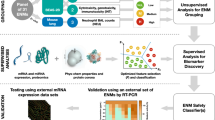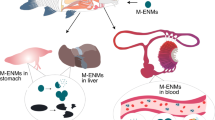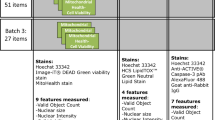Abstract
Evidence continues to grow of the importance of in vitro and in vivo dosimetry in the hazard assessment and ranking of engineered nanomaterials (ENMs). Accurate dose metrics are particularly important for in vitro cellular screening to assess the potential health risks or bioactivity of ENMs. To ensure meaningful and reproducible quantification of in vitro dose, with consistent measurement and reporting between laboratories, it is necessary to adopt standardized and integrated methodologies for (i) generation of stable ENM suspensions in cell culture media; (ii) colloidal characterization of suspended ENMs, particularly of properties that determine particle kinetics in an in vitro system (size distribution and formed agglomerate effective density); and (iii) robust numerical fate and transport modeling for accurate determination of the ENM dose delivered to cells over the course of the in vitro exposure. Here we present an integrated comprehensive protocol based on such a methodology for in vitro dosimetry, including detailed standardized procedures for each of these three critical aims. The entire protocol requires ∼6–12 h to complete.
This is a preview of subscription content, access via your institution
Access options
Access Nature and 54 other Nature Portfolio journals
Get Nature+, our best-value online-access subscription
$29.99 / 30 days
cancel any time
Subscribe to this journal
Receive 12 print issues and online access
$259.00 per year
only $21.58 per issue
Buy this article
- Purchase on Springer Link
- Instant access to full article PDF
Prices may be subject to local taxes which are calculated during checkout






Similar content being viewed by others
References
Ma, X., Wang, Q., Rossi, L., Ebbs, S.D. & White, J.C. Multigenerational exposure to cerium oxide nanoparticles: physiological and biochemical analysis reveals transmissible changes in rapid cycling Brassica rapa. NanoImpact 1, 46–54 (2016).
Pyrgiotakis, G. et al. A chemical free, nanotechnology-based method for airborne bacterial inactivation using engineered water nanostructures. Environ. Sci. Nano 1, 15–26 (2014).
Pyrgiotakis, G. et al. Mycobacteria inactivation using engineered water nanostructures (EWNS). Nanomedicine 10, 1175–83 (2014).
Pyrgiotakis, G. et al. Inactivation of foodborne microorganisms using engineered water nanostructures (EWNS). Environ. Sci. Technol. 49, 3737–45 (2015).
Pyrgiotakis, G. et al. Optimization of a nanotechnology based antimicrobial platform for food safety applications using engineered water nanostructures (EWNS). Sci. Rep. 6, 21073 (2016).
Roco, M.C., Mirkin, C.A. & Hersan, M.C. Nanotechnology Research Directions for Societal Needs in 2020, Retrospective and Outlook (Springer, 2011).
Servin, A.D. & White, J.C. Nanotechnology in agriculture: next steps for understanding engineered nanoparticle exposure and risk. NanoImpact 1, 9–12 (2016).
Sotiriou, G.A. et al. Engineering safer-by-design, transparent, silica-coated ZnO nanorods with reduced DNA damage potential. Environ. Sci. Nano 1, 144–153 (2014).
Bott, J., Störmer, A. & Franz, R. A model study into the migration potential of nanoparticles from plastics nanocomposites for food contact. Food Packag. Shelf Life 2, 73–80 (2014).
Froggett, S.J., Clancy, S.F., Boverhof, D.R. & Canady, R.A. A review and perspective of existing research on the release of nanomaterials from solid nanocomposites. Part. Fibre Toxicol. 11, 17 (2014).
Grassian, V.H. et al. NanoEHS – defining fundamental science needs: no easy feat when the simple itself is complex. Environ. Sci. Nano 3, 15–27 (2016).
Konduru, N.V et al. Silica coating influences the corona and biokinetics of cerium oxide nanoparticles. Part. Fibre Toxicol. 12, 31 (2015).
Lu, X. et al. In vivo epigenetic effects induced by engineered nanomaterials: a case study of copper oxide and laser printer-emitted engineered nanoparticles. Nanotoxicology 10, 629–39 (2016).
Pal, A.K. et al. Linking exposures of particles released from nano-enabled products to toxicology: an integrated methodology for particle sampling, extraction, dispersion, and dosing. Toxicol. Sci. 146, 321–33 (2015).
Watson, C. et al. High-throughput screening platform for engineered nanoparticle-mediated genotoxicity using CometChip technology. ACS Nano 8, 2118–33 (2014).
Yetisen, A.K. et al. Nanotechnology in textiles. ACS Nano 10, 3042–3068 (2016).
Zhou, E.H. et al. Assessing the impact of engineered nanoparticles on wound healing using a novel in vitro bioassay. Nanomedicine (Lond.) 9, 2803–15 (2014).
Balbus, J.M. et al. Meeting report: hazard assessment for nanoparticles--report from an interdisciplinary workshop. Environ. Health Perspect. 115, 1654–9 (2007).
George, S. et al. Use of a high-throughput screening approach coupled with in vivo zebrafish embryo screening to develop hazard ranking for engineered nanomaterials. ACS Nano 5, 1805–17 (2011).
Krewski, D. et al. Toxicity testing in the 21st century: a vision and a strategy. J. Toxicol. Environ. Health B Crit. Rev. 13, 51–138 (2010).
Lai, D.Y. Toward toxicity testing of nanomaterials in the 21st century: a paradigm for moving forward. Wiley Interdiscip. Rev. Nanomed. Nanobiotechnol. 4, 1–15 (2012).
Warheit, D.B., Borm, P.J.A., Hennes, C. & Lademann, J. Testing strategies to establish the safety of nanomaterials: conclusions of an ECETOC workshop. Inhal. Toxicol. 19, 631–43 (2007).
Keller, A.A., McFerran, S., Lazareva, A. & Suh, S. Global life cycle releases of engineered nanomaterials. J. Nanopart. Res. 15, 1692 (2013).
Wigger, H. et al. Influences of use activities and waste management on environmental releases of engineered nanomaterials. Sci. Total Environ. 535, 160–71 (2015).
Pirela, S.V et al. Development and characterization of an exposure platform suitable for physico-chemical, morphological and toxicological characterization of printer-emitted particles (PEPs). Inhal. Toxicol. 26, 400–8 (2014).
Sisler, J.D. et al. Small airway epithelial cells exposure to printer-emitted engineered nanoparticles induces cellular effects on human microvascular endothelial cells in an alveolar-capillary co-culture model. Nanotoxicology 9, 769–79 (2015).
Sotiriou, G.A. et al. An integrated methodology for the assessment of environmental health implications during thermal decomposition of nano-enabled products. Environ. Sci. Nano 2, 262–272 (2015).
Wohlleben, W. et al. On the lifecycle of nanocomposites: comparing released fragments and their in-vivo hazards from three release mechanisms and four nanocomposites. Small 7, 2384–95 (2011).
Pirela, S.V. et al. Effects of intratracheally instilled laser printer-emitted engineered nanoparticles in a mouse model: a case study of toxicological implications from nanomaterials released during consumer use. NanoImpact 1, 1–8 (2016).
Pirela, S.V et al. Consumer exposures to laser printer-emitted engineered nanoparticles: a case study of life-cycle implications from nano-enabled products. Nanotoxicology 9, 760–8 (2015).
Pirela, S. et al. Effects of copy center particles on the lungs: a toxicological characterization using a Balb/c mouse model. Inhal. Toxicol. 25, 498–508 (2013).
Demokritou, P. et al. An in vivo and in vitro toxicological characterisation of realistic nanoscale CeO2 inhalation exposures. Nanotoxicology 7, 1338–50 (2013).
Cohen, J., Deloid, G., Pyrgiotakis, G. & Demokritou, P. Interactions of engineered nanomaterials in physiological media and implications for in vitro dosimetry. Nanotoxicology 7, 417–31 (2013).
Gangwal, S. et al. Informing selection of nanomaterial concentrations for ToxCast in vitro testing based on occupational exposure potential. Environ. Health Perspect. 119, 1539–46 (2011).
Oberdörster, G. Nanotoxicology: in vitro-in vivo dosimetry. Environ. Health Perspect. 120, A13 author reply A13 (2012).
DeLoid, G. et al. Estimating the effective density of engineered nanomaterials for in vitro dosimetry. Nat. Commun. 5, 3514 (2014).
DeLoid, G.M. et al. Advanced computational modeling for in vitro nanomaterial dosimetry. Part. Fibre Toxicol. 12, 32 (2015).
Pal, A.K. et al. High resolution characterization of engineered nanomaterial dispersions in complex media using tunable resistive pulse sensing technology. ACS Nano 8, 9003–15 (2014).
Teeguarden, J.G., Hinderliter, P.M., Orr, G., Thrall, B.D. & Pounds, J.G. Particokinetics in vitro: dosimetry considerations for in vitro nanoparticle toxicity assessments. Toxicol. Sci. 95, 300–12 (2007).
Bakand, S., Winder, C., Khalil, C. & Hayes, A. Toxicity assessment of industrial chemicals and airborne contaminants: transition from in vivo to in vitro test methods: a review. Inhal. Toxicol. 17, 775–87 (2005).
Pyrgiotakis, G., Blattmann, C.O. & Demokritou, P. Real-time nanoparticle-cell interactions in physiological media by atomic force microscopy. ACS Sustain. Chem. Eng. 2, 1681–1690 (2014).
Pyrgiotakis, G., Blattmann, C.O., Pratsinis, S. & Demokritou, P. Nanoparticle-nanoparticle interactions in biological media by atomic force microscopy. Langmuir 29, 11385–95 (2013).
Lundqvist, M. et al. The evolution of the protein corona around nanoparticles: a test study. ACS Nano 5, 7503–7509 (2011).
Buford, M.C., Hamilton, R.F. & Holian, A. A comparison of dispersing media for various engineered carbon nanoparticles. Part. Fibre Toxicol. 4, 6 (2007).
Sharma, G. et al. Iron oxide nanoparticle agglomeration influences dose rates and modulates oxidative stress-mediated dose-response profiles in vitro. Nanotoxicology 8, 663–75 (2014).
Watson, C.Y., DeLoid, G.M., Pal, A. & Demokritou, P. Buoyant nanoparticles: implications for nano-biointeractions in cellular studies. Small 12, 3172–3180 (2016).
Cai, W. The optimized fabrication of nanobubbles as ultrasound contrast agents for tumor imaging. Sci. Rep. 5, 13725 (2015).
DasSarma, S. et al. An improved genetic system for bioengineering buoyant gas vesicle nanoparticles from Haloarchaea. BMC Biotechnol. 13, 112 (2013).
Schmit, V.L., Martoglio, R., Scott, B., Strickland, A.D. & Carron, K.T. Lab-on-a-bubble: synthesis, characterization, and evaluation of buoyant gold nanoparticle-coated silica spheres. J. Am. Chem. Soc. 134, 59–62 (2012).
Suzuki, R. & Maruyama, K. Effective in vitro and in vivo gene delivery by the combination of liposomal bubbles (bubble liposomes) and ultrasound exposure. Methods Mol. Biol. 605, 473–86 (2010).
Wittmaack, K. Excessive delivery of nanostructured matter to submersed cells caused by rapid gravitational settling. ACS Nano 5, 3766–3778 (2011).
Wittmaack, K. Novel dose metric for apparent cytotoxicity effects generated by in vitro cell exposure to silica nanoparticles. Chem. Res. Toxicol. 24, 150–158 (2011).
Pal, A.K., Bello, D., Cohen, J. & Demokritou, P. Implications of in vitro dosimetry on toxicological ranking of low aspect ratio engineered nanomaterials. Nanotoxicology 9, 871–885 (2015).
Cohen, J.M., Teeguarden, J.G. & Demokritou, P. An integrated approach for the in vitro dosimetry of engineered nanomaterials. Part. Fibre Toxicol. 11, 20 (2014).
Cohen, J.M. et al. Tracking translocation of industrially relevant engineered nanomaterials (ENMs) across alveolar epithelial monolayers in vitro. Nanotoxicology 8, 216–25 (2014).
Kreyling, W.G. et al. In vitro and in vivo interactions of selected nanoparticles with rodent serum proteins and their consequences in biokinetics. Beilstein J. Nanotechnol. 5, 1699–711 (2014).
Anjilvel, S. & Asgharian, B. A multiple-path model of particle deposition in the rat lung. Fundam. Appl. Toxicol. 28, 41–50 (1995).
Cassee, F.R. et al. Particle size-dependent total mass deposition in lungs determines inhalation toxicity of cadmium chloride aerosols in rats. Application of a multiple path dosimetry model. Arch. Toxicol. 76, 277–86 (2002).
Geraets, L., Oomen, A.G., Schroeter, J.D., Coleman, V.A. & Cassee, F.R. Tissue distribution of inhaled micro- and nano-sized cerium oxide particles in rats: results from a 28-day exposure study. Toxicol. Sci. 127, 463–73 (2012).
Pirela, S.V et al. Effects of laser printer-emitted engineered nanoparticles on cytotoxicity, chemokine expression, reactive oxygen species, DNA methylation, and DNA damage: a comprehensive in vitro analysis in human small airway epithelial cells, macrophages, and lymphoblasts. Environ. Health Perspect. 124, 210–219 (2016).
Powers, K.W., Palazuelos, M., Moudgil, B.M. & Roberts, S.M. Characterization of the size, shape, and state of dispersion of nanoparticles for toxicological studies. Nanotoxicology 1, 42–51 (2007).
Powers, K.W. et al. Research strategies for safety evaluation of nanomaterials. Part VI. Characterization of nanoscale particles for toxicological evaluation. Toxicol. Sci. 90, 296–303 (2006).
Brown, S.C. et al. Nanoparticle characterization for cancer nanotechnology and other biological applications. Methods Mol. Biol. 624, 39–65 (2010).
Brown, S.C. et al. Influence of shape, adhesion and simulated lung mechanics on amorphous silica nanoparticle toxicity. Adv. Powder Technol. 18, 69–79 (2007).
Crist, R.M. et al. Common pitfalls in nanotechnology: lessons learned from NCI's Nanotechnology Characterization Laboratory. Integr. Biol. (Camb.) 5, 66–73 (2013).
Patri, A. et al. Nanotechnology characterization laboratory: a resource for translational research in nanomedicine. Abstr. Pap. Am. Chem. Soc. 238, COLL 101 (2008).
Warheit, D.B. & Donner, E.M. How meaningful are risk determinations in the absence of a complete dataset? Making the case for publishing standardized test guideline and 'no effect' studies for evaluating the safety of nanoparticulates versus spurious 'high effect' results from single investigative studies. Sci. Technol. Adv. Mater. 16, 034603 (2015).
Cohen, J.M., DeLoid, G.M. & Demokritou, P. A critical review of in vitro dosimetry for engineered nanomaterials. Nanomedicine (Lond.) 10, 3015–3032 (2015).
Schulze, C. et al. Not ready to use – overcoming pitfalls when dispersing nanoparticles in physiological media. Nanotoxicology 2, 51–61 (2008).
Taurozzi, J.S., Hackley, V.A. & Weisner, M.W. Preparation of Nanoparticle Dispersions from Powdered Material Using Ultrasonic Disruption. NIST Special Publication 1200-2, 1–15 (2012) http://dx.doi.org/10.6028/NIST.SP.1200-2.
Taurozzi, J.S., Hackley, V.A. & Wiesner, M.R. Ultrasonic dispersion of nanoparticles for environmental, health and safety assessment--issues and recommendations. Nanotoxicology 5, 711–29 (2011).
Taurozzi, J.S., Hackley, V.A. & Wiesner, M.R. A standardised approach for the dispersion of titanium dioxide nanoparticles in biological media. Nanotoxicology 7, 389–401 (2013).
Wu, W. et al. Dispersion method for safety research on manufactured nanomaterials. Ind. Health 52, 54–65 (2014).
Wohlleben, W. Validity range of centrifuges for the regulation of nanomaterials: from classification to as-tested coronas. J. Nanopart. Res. 14, 1300 (2012).
Sterling, M.C., Bonner, J.S., Ernest, A.N.S., Page, C.A. & Autenrieth, R.L. Application of fractal flocculation and vertical transport model to aquatic sol-sediment systems. Water Res. 39, 1818–30 (2005).
Carney, R.P. et al. Determination of nanoparticle size distribution together with density or molecular weight by 2D analytical ultracentrifugation. Nat. Commun. 2, 335 (2011).
Hinderliter, P.M. et al. ISDD: a computational model of particle sedimentation, diffusion and target cell dosimetry for in vitro toxicity studies. Part. Fibre Toxicol. 7, 36 (2010).
Ma, R. et al. Size-controlled dissolution of organic-coated silver nanoparticles. Environ. Sci. Technol. 46, 752–9 (2012).
Odzak, N., Kistler, D., Behra, R. & Sigg, L. Dissolution of metal and metal oxide nanoparticles in aqueous media. Environ. Pollut. 191, 132–8 (2014).
Kittler, S., Greulich, C., Diendorf, J., Ko¨ller, M. & Epple, M. Toxicity of silver nanoparticles increases during storage because of slow dissolution under release of silver ions. Chem. Mater. 22, 4548–4554 (2010).
Vasyukova, E., Pokrovsky, O.S., Viers, J. & Dupré, B. New operational method of testing colloid complexation with metals in natural waters. Appl. Geochem. 27, 1226–1237 (2012).
Lu, X. et al. Short-term exposure to engineered nanomaterials affects cellular epigenome. Nanotoxicology 10, 140–150 (2015).
Ayán-Varela, M. et al. Achieving extremely concentrated aqueous dispersions of graphene flakes and catalytically efficient graphene-metal nanoparticle hybrids with flavin mononucleotide as a high-performance stabilizer. ACS Appl. Mater. Interfaces 7, 10293–307 (2015).
Zhang, L. et al. Rationally designed surfactants for few-layered graphene exfoliation: ionic groups attached to electron-deficient π-conjugated unit through alkyl spacers. ACS Nano 8, 6663–70 (2014).
Vanhecke, D. et al. Quantification of nanoparticles at the single-cell level: an overview about state-of-the-art techniques and their limitations. Nanomedicine (Lond.) 9, 1885–900 (2014).
Demokritou, P. et al. Development and characterization of a Versatile Engineered Nanomaterial Generation System (VENGES) suitable for toxicological studies. Inhal. Toxicol. 22, 107–116 (2010).
Gass, S. et al. A safer formulation concept for flame-generated engineered nanomaterials. ACS Sustain. Chem. Eng. 1, 843–857 (2013).
Sotiriou, G.A. et al. Thermal decomposition of nano-enabled thermoplastics: possible environmental health and safety implications. J. Hazard. Mater. 305, 87–95 (2016).
Gauss, C.F. Besprechung des Buchs von L.A. Seeber: Untersuchungen über die Eigenschaften der positiven ternären quadratischen Formen usw. Göttingsche Gelehrt. Anzeigen 2, 188–196 (1831).
Song, C., Wang, P. & Makse, H.A. A phase diagram for jammed matter. Nature 453, 629–632 (2008).
Acknowledgements
This research project was supported by a Harvard–National Institute of Environmental Health Sciences Nanosafety Center grant (1U24ES026946) and a National Science Foundation grant (1436450), both awarded to P.D.
Author information
Authors and Affiliations
Contributions
G.M.D., J.M.C., G.P., and P.D. co-wrote the manuscript. P.D. oversaw the manuscript preparation.
Corresponding author
Ethics declarations
Competing interests
The authors declare no competing financial interests.
Supplementary information
Supplementary Software
Supplementary Software. This file contains the MATLAB .m code to run the distorted grid computational dosimetry model as described in the text. (TXT 40 kb)
Supplementary Data
Supplementary Data. This file contains the dosimetry output obtained from running the distorted grid computational model with parameters set as described in the text for an example Fe2O3 ENM. (XLSX 1920 kb)
Rights and permissions
About this article
Cite this article
DeLoid, G., Cohen, J., Pyrgiotakis, G. et al. Preparation, characterization, and in vitro dosimetry of dispersed, engineered nanomaterials. Nat Protoc 12, 355–371 (2017). https://doi.org/10.1038/nprot.2016.172
Published:
Issue Date:
DOI: https://doi.org/10.1038/nprot.2016.172
This article is cited by
-
Effective density of inhaled environmental and engineered nanoparticles and its impact on the lung deposition and dosimetry
Particle and Fibre Toxicology (2024)
-
Strategies to reduce the risks of mRNA drug and vaccine toxicity
Nature Reviews Drug Discovery (2024)
-
Investigation of nanoparticle dispersibility and stability based on TiO2 analysis by SMLS, DLS, and SEM
Journal of Nanoparticle Research (2024)
-
Establishing relationships between particle-induced in vitro and in vivo inflammation endpoints to better extrapolate between in vitro markers and in vivo fibrosis
Particle and Fibre Toxicology (2023)
-
Comparison of cellulose nanocrystal dispersion in aqueous suspension via new and established analytical techniques
Cellulose (2023)
Comments
By submitting a comment you agree to abide by our Terms and Community Guidelines. If you find something abusive or that does not comply with our terms or guidelines please flag it as inappropriate.



